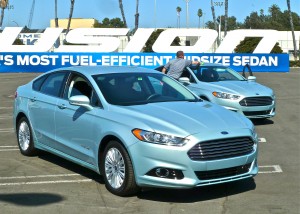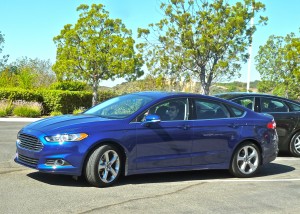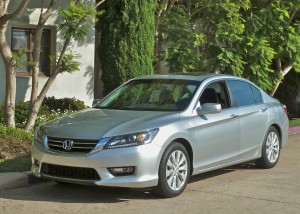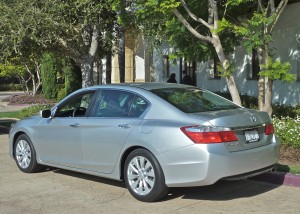Fusion leaps ahead in styling, technology
By John Gilbert
SANTA MONICA, CALIF. — There is no ring hovering above the roof of the 2013 Ford Fusion, but there might as well be, because the completely revised midsize sedan clearly is Ford Motor Company’s the new “halo” vehicle. Ford has impressively redone its vast array of models, most of them over the past year or two, and as impressive as they are, they must fall in line behind the 2013 Ford Fusion.
The new Fusion might be the best and best-looking car ever turned out in Detroit, although General Motors and Chrysler loyalists would strongly argue. But while styling and beauty are definitely subjective, anyone finding fault with the new Fusion’s looks are welcome to raise their hand. The grille and front end resemble the exotic Aston Martin; the sloping rear window and “C” pillars blend into its tail similar to a German Audi A7 sports sedan; and the side offers a thoroughly modern silhouette not unlike an Acura TL of a previous generation. That’s a pretty impressive hat trick from which to draw comparisons.
Ford not only brings those appealing style elements together, it fills the Fusion with enough technology and features that its captivating appearance almost become secondary. Four new engines — and not a V6 among them — take up residence under the Fusion hood, and carry their share of the load, with the largest of the four being the most docile, with tricks such as turbocharging, new hybrid technology, all-wheel drive, plus four transmissions, are all available.
The Fusion already has carved a solid position in the midsize category, which is more competitive than ever, with new models of the Honda Accord, Nissan Altima, and Chevrolet Malibu, with more to come, plus stalwarts like the Toyota Camry, Hyundai Sonata, Kia Optima, and Volkswagen Passat redone in the last year or two. But the new Fusion lives up to nearly a full year of pre-introduction hype and hits the market well-prepared for the battles ahead.
Waves of journalists were brought to Los Angeles, and delivered up the coast to the Casa del Mar, a fancy resort hotel that opens out onto Santa Monica’s legendary beach. Actually, our first stop was three blocks up the street, where we saw a fleet of Fusions parked awaiting us. It was the first time we’d seen the car except on static displays at all of this past year’s auto shows and other major automotive events. But these were ready to move, and they were all hybrids.
In the Fusion scheme of things, a group of 4-cylinder engines gain appreciably from the emergence of EcoBoost technology, which is turbocharging smaller engines to make them respond like larger engines when prodded, but deliver smaller-engine fuel efficiency. The car has 4-cylinder engines with displacement ranging from 1.6 liters, to 2.0, and up to 2.5. Ironically, the 2.5 is the largest, but with no turbocharger and no hybrid boost it is the least powerful, although it can still attain 175 horsepower and an identical 175 foot-pounds of torque — both solid numbers in the midst of the midsizers.
The 2.5 is the standard engine in the basic “S” model Fusion, which has EPA fuel economy estimates of 22 city, 34 highway, and starts at a base price of $21,700. The SE is next, with a base starting at $23,700, with the SE Hybrid starting at $27,200, and the top of the line Titanium starting at $30,200.
Ford has set it up so buyers can choose optional engines and features form the option list in any model. The SE runs strong with an amazing little 1.6-liter EcoBoost engine, with EcoBoost being Ford’s name for its direct-injection and turbocharged technology. The turbo pushes the little 1.6 to 178 horsepower at 5,700 RPMs, with a 184-foot-pound supply of torque at a mere 2,500 RPMs, and EPA estimate of 22-34 miles per gallon.
The 2.0-liter EcoBoost 4 has similar EPA estimates (22 city, 33 highway), but kicks the power up to 240 horses at 5,500 RPMs and 270 foot-pounds of torque at 3,000 revs. Ford offers two numbers for both EcoBoost 4s, suggesting that if owners choose to use regular fuel the horsepower in the 1.6 is reduced from 178 to 171, and in the 2.0 it drops from 240 to 231. Premium fuel undeniably makes the engine perform a bit better, but it’s breakthrough engineering to build an engine that will also run on regular fuel, which can be priced at 20 cents or more under premium, and, at nearly $4 per gallon, can make a large difference at fill-up time. Read more
New Accord takes on midsize challenges
By John Gilbert
The Honda Accord has 36 years rising to prominence and staying there through eight generations, atop the midsize car segment. Things have changed. The completely redone 2013 Accord is just hitting showrooms in mid-September of 2012, and for the first time it faces unprecedented pressure to maintain its status.
At first glance, or more accurately first drive, the new ninth-generation Accord seems quite well equipped to hold its ground, with a smaller size for agility, and new engines and transmissions for improved fuel economy. The question is, does the Accord do enough to turn back cynical accusations that it has been slumbering for a decade, leaving the door open for competitors to catch, or pass it on the open road?
The first generation of the Accord was sold from 1976-81 and was built in Japan. Generation changes came in 1982, with the opening of the Marysville plant, and followed in 1986, 1990, 1994, 1998, 2003, 2008, and now, 2013.
The first seven generations broke an impressive trail. The eighth generation is the one that turned off some Honda loyalists, and therefore provides the challenge for the new car. Honda debated whether to make the eighth-gen car smaller, keep it the same size, or make it larger. There was some who wanted to reduce its length to make it more agile, but when Toyota introduced a new and larger Camry, Honda decided to make the 2008 Accord the largest car in the midsize category.
The current Accord has maintained its financial success, ranking No. 2 in retail sales through the first eight months of 2012, despite aging into its fifth year. But being larger, bulkier, less agile and less fuel-efficient also gave several competitors a good target. Hyundai with its 2011 Sonata, soared in popularity with a highly efficient 2.4-liter direct-injected 4-cylinder engine that raised the standards of power and fuel economy in the segment, and the new Camry, Nissan Altima, Chevrolet Malibu, Ford Fusion and others rallied to raise their standards, too.
Honda has addressed those competitors with the 2013 model, which has an overall length of 191.3 inches — 3.6 inches shorter than the current car — on an inch-shorter wheelbase of 109.3, yet increases interior room. The more stylishly sculptured form is filled with features and new technology, including a new hybrid system at the top of the model array.
Shoji Matsui joined Honda 30 years ago, just in time to work on the 1986 Accord, and he designed the new Accord. He said the new car, has “all the power of Honda, with no excuses. The sedan has the winning formula of universal styling, that will never get old. We didn’t want high side sills,” he added, without mentioning the Chrysler 300, Dodge Charger, Ford Taurus, or others that have that design. Read more
Two models lead the way to Santa Fe
By John Gilbert
PARK CITY, UTAH — Maybe it’s simply a translation issue, from South Korea to the United States, but the Santa Fe has never been introduced in Santa Fe, New Mexico. Hyundai also has a compact SUV named Tucson, which has never been introduced in Arizona. Go figure.
Nobody, however, is pleading for geographic logic in opposition to the site of Park City, Utah, where the 2013 Santa Fe Sport was introduced, complete with side trips to Sundance and the Olympic Park training facility.
In setting the stage for the increased luxury of the vehicle, we were dropped off 45 minutes west of Salt Lake City at the luxurious Montage Resort, nestled up in the trees at 8,347 feet of mountain altitude. It was the perfect place to show off the ability of the 2013 Santa Fe Sport’s turbocharged 2.0-liter engine, which easily coped with such a high-altitude drain on power.
The decidedly upscale revision to the Santa Fe has a flashy, bright chrome grille serving notice that its third generation intends to show its maturity by stepping above and beyond the subtle but efficient current model to become two vehicles in one.
The 2.0-turbo scored well in all maneuvers sending the Santa Fe Sport across some twisting mountain roads, and some rougher gravel back roads, although we didn’t do any off-roading that would qualify as being worse than a rural Northern Minnesota driveway. We only got the chance to drive the Santa Fe Sport with its 2.0-turbocharged 4-cylinder engine, while still to come is the same vehicle with the 2.4 GDI (gas direct-injection), both of those with compact 184.6-inch length. In a curious bit of name-calling, the actual vehicle called Santa Fe will stretch into an elongated 193.1-inch, three-row-seat version with a 3.3-liter V6, as it becomes a vehicle for all reasons. The new Santa Fe is not only a luxurious, upscale replacement of the current Santa Fe as the Sport, but it also grows to longer form to replace the larger Veracruz — an impressive top-end model, which will disappear in favor of the Santa Fe’s expanded intentions.
All Santa Fe models come with front-wheel drive or all-wheel drive, which is reflected in their price structure. The Santa Fe Sport 2.4 has a base price of $24,450 (FWD) and $26,200 (AWD); the Sport 2.0-Turbo runs from $27,700 (FWD) to $29,450 (AWD). Pricing on the elongated model will follow its introduction. Read more







 John Gilbert is a lifetime Minnesotan and career journalist, specializing in cars and sports during and since spending 30 years at the Minneapolis Tribune, now the Star Tribune. More recently, he has continued translating the high-tech world of autos and sharing his passionate insights as a freelance writer/photographer/broadcaster. A member of the prestigious North American Car and Truck of the Year jury since 1993. John can be heard Monday-Friday from 9-11am on 610 KDAL(www.kdal610.com) on the "John Gilbert Show," and writes a column in the Duluth Reader.
John Gilbert is a lifetime Minnesotan and career journalist, specializing in cars and sports during and since spending 30 years at the Minneapolis Tribune, now the Star Tribune. More recently, he has continued translating the high-tech world of autos and sharing his passionate insights as a freelance writer/photographer/broadcaster. A member of the prestigious North American Car and Truck of the Year jury since 1993. John can be heard Monday-Friday from 9-11am on 610 KDAL(www.kdal610.com) on the "John Gilbert Show," and writes a column in the Duluth Reader.